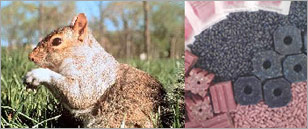Rodenticides
We are a highly reputed company, engaged in manufacturing and formulation of wide range of effective rodenticides. It is a far-famed public figure in the exporting business of Rodenticides. It is defined as a substance that is used to kill rats, mice, and other rodent pests. We are starving to provide the most effective rodenticides.

There are two categories of anti-coagulant type rodent toxicants, the COURMARINS and the INDANDIONES. Courmarins incorporates some very common rodent toxicants such as bromadiolone, warfarin and courmafuryl. While on the other hand, Indandiones include the rodent toxicants diphacionone and chlorophacinone.
Exposure to these chemicals has a semipermanent health consequences. For example, the courmarin and warfarin have been depicted to cause paralysis due to cerebral bleeding and is teratogenic (causes birth defects). Long-term exposure to the indandione and diphacinone results into nerve, heart, liver, and kidney impairment as well as damage to skeletal muscularities.
Rodenticides belong to a family of pest control chemicals meant to kill rodents. Rodents are hard to kill with toxicants because their preying habits reflect their place as scavengers. They will eat a small amount of something and wait, and if they don't feel any sickness, they continue to eat. An effective rodenticide must be savorless and inodorous in deadly concentrations, and have a retarded consequence. Chemicals such as sulfur dioxide, carbon monoxide, hydrogen cyanide and methyl bromide are effective rodenticides. These compounds are purely based upon different types of lethal chemicals. For example:
Bromethalin
Bromethalin is a lethal compound whose single-dose leads to paralysis and depression in central nervous system, resulting to death in couple of days. Bait should be renewed at intervals of certain days. Continuous bait accessibility is not required, but bait requires to be present long enough to grant all animals in the area to feast. The measure of bait demanded is normally about one-third that is used with anticoagulants, since an animal consuming a deadly dose does not feed again. This consequence is different from that of anticoagulants, in which rodents carry on to consume bait after they have ingested a lethal dose. Bait timidness has not been accounted.
Aluminium phosphide
Aluminium Phosphide is a grey-green-yellow powder which is due to the presence of impurities originating hydrolysis and oxidation. This material is a wide circle gap semiconductor unit and is used as a fumigant. It is commonly used as a rodenticide, insecticide and fumigant for stored cereal grains. It is also applied to kill small offensive mammalians such as rabbits, moles and rodents. Its strong garlic-like odor appears to be attractive to rodents that are not bait-shy and apparently makes the bait unattractive to some other animals.
Zinc phosphide
Zinc phosphide is a powder, indissoluble in water, that has been used extensively in the control of rodents. When zinc phosphide comes into touch with dilute acids in the stomach, phosphine is liberated. It is this substance that believably causes death. Rats and mice that ingest lethal amounts of bait usually buckle under overnight with terminal symptoms of paralysis, convulsions, coma, and death from asphyxia. They typically die in a prone position with their legs and tails outstretched. Because zinc phosphide is not stored in muscle or other tissues of poisoned animals, there is no subaltern intoxication with this rodenticide. However, the bait remains toxic up to several days in the gut of a dead rodent. Other animals can be poisoned if they eat enough of the gut content of rodents recently shot down with zinc phosphide.
